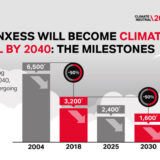
Covestro and LANXESS cooperate to reduce their carbon footprint
Covestro AG and LANXESS AG are cooperating in the energy-intensive production of basic chemicals at their Lower Rhine sites in Germany to reduce their carbon footprint.
Chlorine, caustic soda and hydrogen are basic building blocks for many products in the chemical industry. However, their production is very energy-intensive.
LANXESS sources chlorine, caustic soda and hydrogen from the ISCC PLUS-certified sites of Covestro in Leverkusen and Krefeld-Uerdingen. Covestro produces the three basic raw materials at its North RhineWestphalian sites in Leverkusen, Krefeld-Uerdingen, as well as Dormagen.
With immediate effect, Covestro is manufacturing around one-third of the volume of products it supplies using energy from hydropower based on guarantees of origin.
”Covestro is pursuing the goal of completely converting its production to electricity from renewable sources on its path to operational climate neutrality in 2035,” said Dr. Klaus Schäfer, chief technology officer of Covestro, which arose from the Bayer Group’s chemicals and plastics unit.
“A particular focus is on the energy-intensive production of basic raw materials. In cooperation with LANXESS, we use energy in our electrolysis plants in North Rhine-Westphalia on a pro-rata basis, which enables us to reduce our reported emissions by up to 120,000 metric tons of CO2 per year.”
“The joint project with Covestro is an important building block in making our entire value chain climate-neutral. By sourcing raw materials for these products with a significantly reduced carbon
footprint, we will be able to reduce our reported indirect emissions by up to 120,000 metric tons of CO2 equivalents per year,” said Dr. Hubert Fink, member of the LANXESS Board of Management. With its Net Zero Value Chain Initiative, the Cologne-based specialty chemicals company plans to eliminate Scope 3 emissions within its upstream and downstream supply chain by 2050. This includes indirect emissions, particularly from purchased raw materials, but also in logistics or disposal. For Scope 1 and 2 emissions, the company aims to be climate neutral by 2040.
“With this program, we are taking the next step towards a climate-neutral product portfolio and are also supporting our customers, who are increasingly looking for sustainable solutions,” said Fink.
.jpg)







